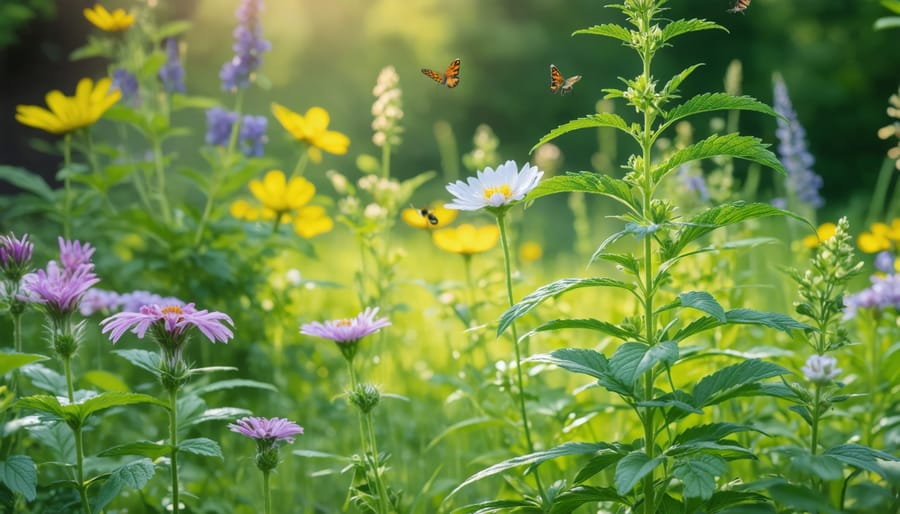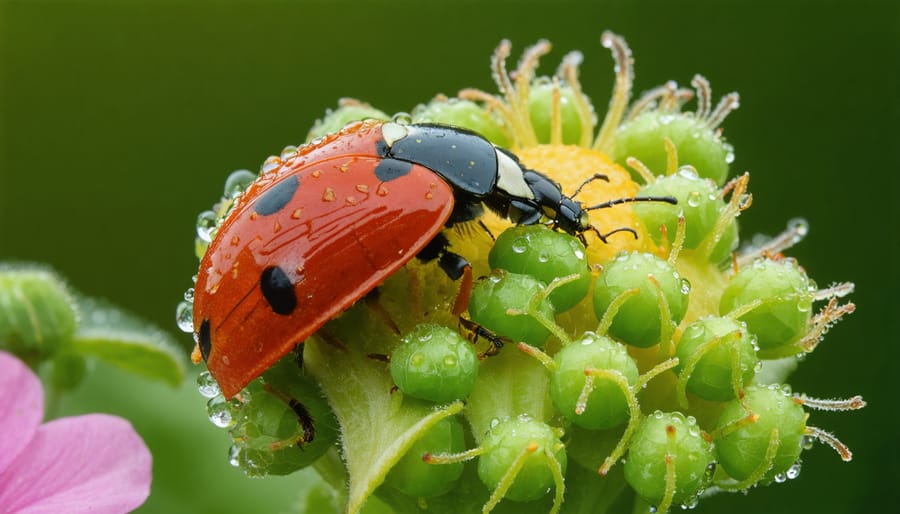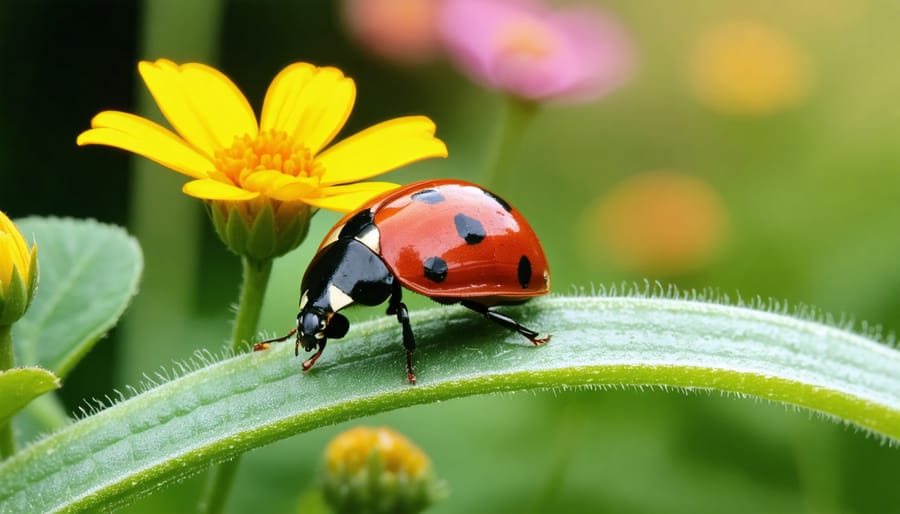Imagine stepping into your garden where ladybugs patrol your roses, lacewings guard your vegetables, and ground beetles keep slugs at bay—all while you sip your morning coffee. This isn’t a fantasy; it’s the reality of biological pest control, and it’s revolutionizing how home gardeners protect their plants.
When you invite beneficial insects into your garden, you’re enlisting nature’s most efficient pest management team. These tiny allies work around the clock, eliminating aphids, caterpillars, and other plant-damaging insects without you lifting a finger. Unlike chemical pesticides that require repeated applications and careful timing, beneficial insects reproduce and establish themselves, creating a self-sustaining defense system that gets stronger over time.
The benefits extend far beyond convenience. You’ll save money on pest control products, protect your family and pets from chemical exposure, and create a thriving ecosystem that supports pollinators and local wildlife. Your vegetables become truly organic, your soil remains healthy, and you’ll notice your garden coming alive with birdsong and butterfly visits.
Best of all, attracting these helpful insects requires simple changes any gardener can make—no specialized knowledge or expensive equipment necessary. Let’s explore how these remarkable creatures can transform your gardening experience while making your outdoor space healthier and more vibrant.
What Makes an Insect ‘Beneficial’?
Think of beneficial insects as nature’s garden warriors—the good guys who patrol your plants looking for troublemakers to eliminate. When we call an insect “beneficial,” we simply mean it helps us by controlling pest populations naturally, saving our gardens from damage without us lifting a finger (or a spray bottle).
These helpful insects fall into two main categories, and understanding the difference is easier than you might think. **Predators** are the hunters of the insect world. They actively seek out and consume pests, much like a ladybug munching through dozens of aphids in a single day. You’ll often see them in action—it’s quite the spectacle! Think of lacewings, ground beetles, and those charming ladybugs we all recognize.
**Parasitoids** work more stealthily. These insects lay their eggs on or inside pest insects, and when the eggs hatch, the larvae feed on their host. I know it sounds a bit like science fiction, but tiny parasitic wasps are absolute champions at controlling caterpillars and aphids this way. Don’t worry—these wasps are so small you’ll barely notice them, and they have zero interest in people.
The beauty of beneficial insects is that they’re self-sufficient pest controllers. Once established in your garden, they’ll continue their work season after season, creating a natural balance that keeps pest populations in check without any effort from you.
The Real Benefits of Natural Pest Control
Healthier Plants Without the Chemical Hangover
When you invite beneficial insects into your garden, you’re essentially hiring a natural pest control team that doesn’t leave behind toxic residues or harmful chemicals. This means you can finally let your kids run barefoot through the garden or allow your dog to sniff around the tomato plants without worrying about pesticide exposure.
I’ll never forget chatting with master gardener Patricia Chen, who transformed her conventional garden into a beneficial insect haven. “Within six months, I went from spraying weekly to not touching a pesticide bottle at all,” she told me. “My grandson can now pick raspberries straight from the bush without me panicking about what he’s putting in his mouth.”
The beauty of beneficial insects is that they target specific pests without creating collateral damage. Ladybugs feast on aphids but won’t harm the bees pollinating your squash blossoms. Lacewings eliminate whiteflies while leaving your butterfly visitors completely untouched. This precision is something chemical sprays simply can’t match—they’re more like using a sledgehammer when you need a scalpel.
By embracing these earth-friendly pest control methods, you’re creating a garden ecosystem where safety and productivity go hand in hand. Your plants stay healthy, your family stays safe, and you can actually enjoy your outdoor space without that lingering chemical smell or the nagging worry about what’s seeping into your soil and waterways.

Your Garden Becomes Self-Regulating
Here’s the beautiful truth about inviting beneficial insects into your garden: once they’ve moved in and multiplied, they handle pest control for you. Think of it as creating your own security team that works around the clock without requiring supervision.
When you’ve successfully established populations of ladybugs, lacewings, parasitic wasps, and other helpful insects, they create a natural balance that keeps pest numbers manageable. These beneficial insects reproduce in your garden, meaning their offspring continue the work generation after generation. You’ll notice fewer aphid colonies, reduced caterpillar damage, and healthier plants overall—all without reaching for sprays or spending hours hand-picking pests.
This self-sustaining cycle is part of an integrated pest management approach that works with nature rather than against it. Sure, you’ll still see some pests—that’s normal and necessary to feed your beneficial insect population—but they won’t reach damaging levels.
The best part? Your role shifts from constant warrior to occasional observer. A quick morning walk through the garden becomes your main task, simply checking that the balance remains intact. More time for enjoying your morning coffee among the flowers, less time battling infestations.
Save Money While Growing Better Food
Let’s talk about something that makes every gardener smile: saving money while harvesting better produce! When you partner with beneficial insects, you’re essentially hiring free pest control that works around the clock.
Consider this: a bottle of organic pesticide costs anywhere from $15 to $40 and needs reapplying every week or two during peak season. That’s potentially $200+ per growing season! Meanwhile, attracting beneficial insects requires a one-time investment in companion plants like alyssum or yarrow—usually under $20 for seeds that keep giving year after year.
But here’s where it gets even better. I’ve noticed my tomatoes and peppers have fewer blemishes since ladybugs and lacewings took up residence in my garden. Pest-free produce simply looks more appealing and tastes better too. No more tossing half-damaged vegetables or settling for subpar harvests.
My neighbor Sarah switched to beneficial insects three years ago and tracked her savings. She spent $150 less on pest control products annually, plus her CSA customers raved about the improved quality of her produce. She even raised her prices slightly because the vegetables were so pristine!
The beauty of this approach? Your investment compounds over time as beneficial insect populations establish themselves, creating a self-sustaining system that protects both your wallet and your harvest quality season after season.
Peace of Mind for Eco-Conscious Gardeners
For those of us who care deeply about our environmental footprint, natural pest regulation offers something truly special: the ability to garden in harmony with nature rather than against it. When you invite beneficial insects into your garden, you’re not just solving a pest problem—you’re becoming part of a thriving ecosystem.
I’ve spoken with several organic gardeners who’ve shared how rewarding it feels to watch ladybugs patrol their tomato plants or lacewings hunt among their roses. They’re protecting the birds, bees, and butterflies that visit their gardens by eliminating toxic chemical exposure. These creatures don’t discriminate—pesticide drift can harm the very pollinators we’re trying to attract.
There’s also the water quality angle that many gardeners don’t initially consider. Chemical pesticides wash into storm drains and eventually reach streams and rivers, affecting aquatic life and drinking water supplies. By choosing biological pest control, you’re preventing this harmful runoff entirely.
Plus, you can feel good knowing you’re creating a safe space for children and pets to explore freely without worrying about chemical residues on plants or soil. It’s gardening with a clear conscience.
Meet Your Garden’s Tiny Workforce

Ladybugs: The Garden’s Favorite Predator
Those cheerful red and black beetles dotting your roses aren’t just adorable—they’re voracious pest-fighting machines! A single ladybug can devour up to 5,000 aphids in its lifetime, making them your garden’s most efficient cleanup crew.
What’s on their menu? Primarily aphids, but they’ll also happily munch on mealybugs, scale insects, and spider mites. Think of them as your garden’s tiny, tireless security team working around the clock.
Want to roll out the welcome mat for these spotted helpers? Plant their favorites: dill, fennel, yarrow, and sweet alyssum. These flowering plants provide the pollen and nectar adult ladybugs need between pest-hunting sessions. I’ve noticed that even a small patch of these flowers can transform your garden into a ladybug haven within weeks.
Here’s a fun fact from master gardener Susan Chen: “I stopped using pesticides three years ago and welcomed ladybugs instead. My aphid problem disappeared, and I saved money on sprays!” Her experience mirrors what many gardeners discover—nature often provides the best solutions.
Lacewings: Delicate but Deadly
Don’t let their delicate, fairy-like wings fool you—lacewings are fierce allies in your garden! While the adults flutter gracefully among your plants, it’s their larvae that truly earn their keep. These tiny, alligator-shaped hunters are absolute aphid-demolishing machines, with a single larva consuming up to 200 aphids per week. They don’t stop there, either—mealybugs, whiteflies, spider mites, and other soft-bodied pests are all on the menu.
I like to think of lacewing larvae as your garden’s cleanup crew, patrolling leaves and stems for troublemakers. They’re particularly effective because they’re active hunters rather than ambush predators, meaning they’ll actively seek out pest colonies. You can attract lacewings by planting flowering herbs like dill, fennel, and coriander, which provide the nectar adult lacewings need for energy and reproduction.
Parasitic Wasps: Tiny But Mighty Allies
Don’t let the name scare you—parasitic wasps are some of your garden’s best friends! These tiny insects, often smaller than a grain of rice, are completely harmless to humans. Unlike their yellow-jacket cousins, they don’t sting people at all.
What makes them mighty? They’re incredibly effective pest controllers, targeting caterpillars, aphids, and whiteflies by laying eggs inside or on these pests. As the wasp larvae develop, they naturally eliminate the problem insects without any effort on your part.
You’ve likely seen their work without realizing it—those white cocoons on tomato hornworms? That’s parasitic wasps in action! By welcoming these miniature allies into your garden with diverse flowering plants like yarrow and alyssum, you’re recruiting a tireless pest-control team that works around the clock, keeping your vegetables and flowers safe naturally.
Ground Beetles and Other Unsung Heroes
While ladybugs and lacewings often steal the spotlight, your garden hosts an incredible supporting cast of pest controllers you might never notice! Ground beetles, those shiny dark beetles scurrying under mulch, are voracious nighttime hunters that devour slugs, snail eggs, and soil-dwelling pests. I’ve watched them patrol my vegetable beds like tiny security guards after sunset.
Hoverflies deserve special mention—these bee mimics might startle you at first, but their larvae consume aphids by the hundreds. One hoverfly larva can polish off 400 aphids before reaching adulthood! Similarly, predatory mites work tirelessly among your plant leaves, targeting spider mites and thrips that damage tender growth.
And don’t overlook assassin bugs, aptly named for their hunting prowess. These stealthy predators pierce their prey with needle-like mouthparts, controlling caterpillars, beetles, and even stinkbugs.
The beauty of these unsung heroes? They’re likely already in your garden, quietly doing the heavy lifting. By avoiding broad-spectrum pesticides and providing habitat diversity, you’re supporting an entire ecosystem of beneficial insects working around the clock to keep pests in check.
How to Welcome Beneficial Insects to Your Garden
Plant a Welcome Mat They Can’t Resist
Rolling out the welcome mat for beneficial insects is easier than you might think! Start with flat-topped flowers like yarrow, dill, and fennel—their landing-pad blooms make perfect pit stops for tiny predators like lacewings and parasitic wasps. Sweet alyssum is a garden superstar, attracting hoverflies whose larvae devour aphids by the hundreds.
For a continuous buffet, plant herbs like cilantro, parsley, and basil, letting a few bolt to flower. These companion plants that attract beneficials double as kitchen staples! Add some native wildflowers like coneflowers and black-eyed Susans for season-long appeal.
Here’s my favorite trick: cluster these plants in small patches rather than single specimens. Beneficial insects are more likely to stick around when they find a concentrated food source. Plant early bloomers like calendula in spring, follow with summer favorites like cosmos and zinnias, then finish with fall asters. This succession ensures your garden helpers have reasons to stay all season long.
Position these flowering allies near your vegetable beds—within ten feet works wonderfully—so your beneficial insects can easily patrol both areas.

Create Habitat and Shelter
Think of beneficial insects as tiny houseguests who need comfortable accommodations to stick around! Creating welcoming habitats doesn’t require fancy equipment—just a few thoughtful touches around your garden.
Start by leaving some “messy” spots where insects can overwinter. A pile of leaves tucked in a corner, hollow plant stems left standing through winter, or a small stack of untreated wood creates perfect hideaways for ladybugs and lacewings seeking shelter from the cold.
Water is essential too! A shallow dish filled with pebbles and water gives these helpful allies a safe drinking spot without the risk of drowning. Refresh it regularly, especially during hot weather.
Consider installing a simple bug hotel—stacked bamboo tubes, drilled wooden blocks, or bundled twigs secured together. I built one last spring using materials from my shed, and by summer, it was buzzing with activity! These structures provide nesting sites for solitary bees and other beneficial insects that patrol your garden, keeping pest populations naturally in check while making your space their permanent home.
Rethink Your Pest Tolerance
Here’s a liberating truth: a “perfect” garden isn’t a pest-free garden. In fact, those aphids on your roses or caterpillars nibbling your cabbage leaves serve an important purpose—they’re the buffet that attracts beneficial insects to your yard.
Think of a few pests as an investment rather than a problem. Ladybugs, lacewings, and parasitic wasps need something to eat, and they prefer hunting live prey. Without any pests present, these helpful allies simply won’t stick around. It’s like inviting dinner guests but not serving food!
This doesn’t mean letting pests destroy your plants. Instead, embrace a threshold mindset. A little leaf damage here, some chewed edges there—these minor imperfections signal a thriving ecosystem at work. I’ve learned that my garden actually looks healthier overall when I tolerate small pest populations, because the beneficial insects keep everything in natural balance.
Your garden doesn’t need to be magazine-perfect to be beautiful and productive. It just needs to be alive, buzzing, and working with nature.
Common Mistakes That Send Good Bugs Packing
We’ve all been there—wanting to create the perfect garden and accidentally making choices that drive away our helpful bug friends. The good news? These mistakes are easy to fix once you know what to watch for!
One of the most common slip-ups is reaching for broad-spectrum pesticides at the first sign of trouble. Even organic options can harm beneficial insects if they’re not selective. These products don’t distinguish between the aphid munching on your roses and the ladybug that would have eaten it for lunch. If you must spray, opt for targeted treatments and apply them in the evening when beneficial insects are less active.
Another mistake I see often is creating a too-tidy garden. I know—it seems counterintuitive! But raking up every fallen leaf and removing all plant debris eliminates winter shelter for ground beetles, native bees, and other helpful species. Leave some leaf litter in garden corners and let a few hollow stems stand through winter. Your beneficial bugs will thank you come spring.
Planting only non-native ornamentals, while beautiful, can leave beneficial insects without proper food sources. Many native beneficial species have evolved alongside native plants and depend on them for nectar and pollen. Mixing in regional native flowers creates a more welcoming habitat.
Finally, overwatering and over-fertilizing can actually encourage pest problems by creating lush, tender growth that attracts aphids and other sap-suckers. This forces you into a reactive pest-control mode rather than letting your beneficial insects handle things naturally. Water deeply but less frequently, and feed plants moderately to maintain balanced, healthy growth that’s naturally more pest-resistant.
You’ve discovered something truly remarkable—that nature has already designed the perfect pest control system, and all you need to do is welcome it into your garden. By inviting beneficial insects to work alongside you, you’re not just protecting your plants; you’re creating a thriving ecosystem that practically takes care of itself. The beauty of this approach is that you don’t need to transform your entire garden overnight. Start with a small patch of native flowers, leave a corner a bit wild, or simply skip the pesticides this season and see what happens.
Every gardener who’s made this shift will tell you the same thing: once you start noticing the lacewings on your roses or the ground beetles patrolling your vegetable beds, you’ll wonder why you ever relied on anything else. You’re joining a growing community of gardeners who’ve learned to work with nature rather than against it, and the results speak for themselves—healthier plants, fewer pests, and a garden that feels truly alive.
So take that first step today. Your garden—and the beneficial insects waiting to call it home—are ready when you are.




